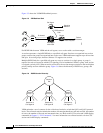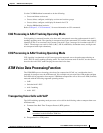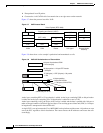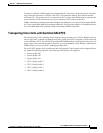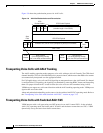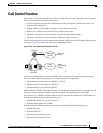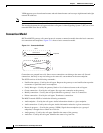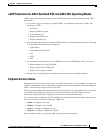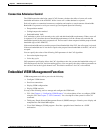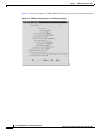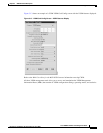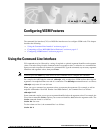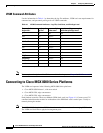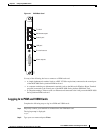
3-18
Cisco VISM Installation and Configuration Guide
Release 3.0, Part Number OL-2521-01 Rev. D0, June 2004
Chapter 3 VISM Functional Description
Call Control Function
If an alarm condition on a line is raised, all endpoints on the line are brought into a forced transition to
OOS. An automatic return to IS is performed when the alarm is cleared, unless a specific OOS command
is executed in the meantime.
Restart In Progress Command
The call agent is kept informed of the state of all endpoints with the xGCP Restart In Progress (RSIP)
command. The following minimum requirements must be met for this process to operate:
• At least one call agent must be configured using the add media gateway controller (addmgc)
command.
• A protocol must be added for each media gateway controller using the add media gateway group
entry command (addmgcgrpentry) command.
The VISM card issues an RSIP command in the following situations:
• One or more endpoints are added or deleted with the following commands:
–
addendpt
–
addendpts
–
delendpt
–
delendpts
• A line is configured as IS or OOS with one of the following commands:
–
cnflnis
–
cnflnoos
• The VISM card (gateway) is configured as IS or OOS with one of the following commands:
–
cnfgwis
–
cnfgwoos
• The VISM card is powered up or reset.
Note In this case, the RSIP is delayed by a random amount (up to a configurable maximum
duration) to avoid an avalanche of RSIPs arriving at the call agent when an entire MGX
8000 series platform with multiple VISM cards is powered up or reset.
When the states of multiple endpoints are changed simultaneously, the VISM card minimizes the number
of RSIP commands through the use of the wildcard ( * ) convention of naming endpoints.
When an RSIP is sent to call agents, VISM expects an acknowledgment. If no acknowledgment is
received after a timeout period, the RSIP is sent again. This process is repeated a number of times, after
which, if no acknowledgment is received, an acknowledgment is assumed. You can configure both the
timeout period and the number of retries with the cnfxgcpretry command.



